Proteomic Analysis of Irradiation with Millimeter Waves on Soybean Growth under Flooding Conditions
Abstract
1. Introduction
2. Results
2.1. Morphological Analysis of Soybean Irradiated with Millimeter Waves
2.2. Identification and Functional Investigation of Proteins in Root-Hypocotyl Tissue of Soybean Irradiated with Millimeter Waves
2.3. Identification of Metabolic Pathways Related to Millimeter-Waves Irradiation in Soybean during Growth
2.4. Immunoblot Analysis of Proteins involved in Ascorbate/Glutathione Metabolism and Glycolysis in Soybean Root during Flooding
3. Discussion
3.1. Millimeter-Waves Irradiation on Soybean Seeds Improved Early-Stage Soybean Growth and Flooding Tolerance
3.2. Millimeter-Waves Irradiation Promoted Carbohydrate Metabolism for Energy Production
3.3. Millimeter-Waves Irradiation Differentially Regulated Redox-Related Pathways for Tolerance under Oxidative Stress
4. Materials and Methods
4.1. Plant Material, Millimeter Wave Irradiation, and Treatment
4.2. Protein Extraction
4.3. Protein Enrichment, Reduction, Alkylation, and Digestion
4.4. Protein Identification Using Nano-Liquid Chromatography Mass Spectrometry
4.5. Mass Spectrometry Data Analysis
4.6. Differential Analysis of Proteins Using Mass Spectrometry Data
4.7. Functional Predictions
4.8. Immunoblot Analysis
4.9. Statistical Analysis
4.10. Accession Code
5. Conclusions
Supplementary Materials
Author Contributions
Funding
Conflicts of Interest
Abbreviations
| LC | Liquid chromatography |
| MS | Mass spectrometry |
| PD | Protein discoverer |
| FDR | False discovery rate |
| CBB | Coomassie brilliant blue |
| APX | Ascorbate peroxidase |
| GR | Glutathione reductase |
| PRX | Peroxiredoxin |
| FBPA | Fructose-bisphosphate aldolase |
| TPI | Triose phosphate isomerase |
| GAPDH | Glyceraldehyde 3-phosphate dehydrogenase |
| PCA | Principle component analysis |
References
- Chen, W.M.; Moulin, L.; Bontemps, C.; Vandamme, P.; Béna, G.; Boivin-Masson, C. Legume symbiotic nitrogen fixation by β-proteobacteria is widespread in nature. J. Bacteriol. 2003, 185, 7266–7272. [Google Scholar] [CrossRef] [PubMed]
- Schutyser, M.A.I.; Pelgrom, P.J.M.; Van der Goot, A.J.; Boom, R.M. Dry fractionation for sustainable production of functional legume protein concentrates. Trends Food Sci. Technol. 2015, 45, 327–335. [Google Scholar] [CrossRef]
- Jeske, S.; Zannini, E.; Arendt, E.K. Evaluation of physicochemical and glycaemic properties of commercial plant-based milk substitutes. Plant Foods Hum. Nutr. 2017, 72, 26–33. [Google Scholar] [CrossRef] [PubMed]
- Schutyser, M.A.I.; Van der Goot, A.J. The potential of dry fractionation processes for sustainable plant protein production. Trends Food Sci. Technol. 2011, 22, 154–164. [Google Scholar] [CrossRef]
- Hartman, G.L.; West, E.D.; Herman, T.K. Crops that feed the world 2. Soybean-worldwide production, use, and constraints caused by pathogens and pests. Food Secur. 2011, 3, 5–17. [Google Scholar] [CrossRef]
- Komatsu, S.; Hiraga, S.; Yanagawa, Y. Proteomics techniques for the development of flood tolerant crops. J. Proteome Res. 2012, 11, 68–78. [Google Scholar] [CrossRef] [PubMed]
- Russell, D.A.; Wong, D.M.L.; Sachs, M.M. The anaerobic response of soybean. Plant Physiol. 1990, 92, 401–407. [Google Scholar] [CrossRef]
- Dennis, E.S.; Dolferus, R.; Ellis, M.; Rahman, M.; Wu, Y.; Hoeren, F.U.; Grover, A.; Ismond, K.P.; Good, A.G.; Peacock, W.J. Molecular strategies for improving water-logging tolerance in plants. J. Exp. Bot. 2000, 51, 89–97. [Google Scholar] [CrossRef]
- Jackson, M.B. Rapid injury to peas by soil waterlogging. J. Sci. Food Agric. 1979, 30, 143–152. [Google Scholar] [CrossRef]
- Grable, A.R.; Danielson, R.E. Effect of carbon dioxide, oxygen, and soil moisture suction on germination of corn and soybeans. Soil Sci. Soc. Am. J. 1965, 29, 12–18. [Google Scholar] [CrossRef]
- Gibbs, J.; Greenway, H. Mechanisms of anoxia tolerance in plants. I. Growth, survival and anaerobic catabolism. Funct. Plant Biol. 2003, 30, 1–47. [Google Scholar] [CrossRef]
- McWilliams, D.A.; Berglund, D.R.; Endres, G.J. Soybean Growth and Management Quick Guide; North Dakota State University Fargo: Fargo, ND, USA, 1999. [Google Scholar]
- Nakayama, N.; Hashimoto, S.; Shimada, S.; Takahashi, M.; Kim, Y.; Oya, T.; Arihara, J. The effect of flooding stress at the germination stage on the growth of soybean in relation to initial seed moisture content. Jpn. J. Crop Sci. 2004, 74, 325–329. (In Japanese) [Google Scholar] [CrossRef][Green Version]
- Yanagawa, Y.; Komatsu, S. Ubiquitin/proteasome-mediated proteolysis is involved in the response to flooding stress in soybean roots, independent of oxygen limitation. Plant Sci. 2012, 185, 250–258. [Google Scholar] [CrossRef] [PubMed]
- Mathesius, U.; Djordjvic, M.A.; Oakes, M.; Goffard, N.; Haerizadeh, F.; Weiller, G.F.; Singh, M.B.; Bhalla, P.L. Comparative proteomic profiles of the soybean (Glycine max) root apex and differentiated root zone. Proteomics 2011, 11, 1707–1719. [Google Scholar] [CrossRef] [PubMed]
- Shi, F.; Yamamoto, R.; Shimamura, S.; Hiraga, S.; Nakayama, N.; Nakamura, T.; Yukawa, K.; Hachinohe, M.; Matsumoto, H.; Komatsu, S. Cytosolic ascorbate peroxidase 2 (cAPX 2) is involved in the soybean response to flooding. Phytochemistry 2008, 69, 1295–1303. [Google Scholar] [CrossRef] [PubMed]
- Komatsu, S.; Han, C.; Nanjo, Y.; Altaf-Un-Nahar, M.; Wang, K.; He, D.; Yang, P. Label-free quantitative proteomic analysis of abscisic acid effect in early-stage soybean under flooding. J. Proteome Res. 2013, 12, 4769–4784. [Google Scholar] [CrossRef]
- Komatsu, S.; Nanjo, Y.; Nishimura, M. Proteomic analysis of the flooding tolerance mechanism in mutant soybean. J. Proteom. 2013, 79, 231–250. [Google Scholar] [CrossRef]
- Li, X.; Rehman, S.U.; Yamaguchi, H.; Hitachi, K.; Tsuchida, K.; Yamaguchi, T.; Sunohara, Y.; Matsumoto, H.; Komatsu, S. Proteomic analysis of the effect of plant-derived smoke on soybean during recovery from flooding stress. J. Proteom. 2018, 181, 238–248. [Google Scholar] [CrossRef]
- Sheen, D.M.; McMakin, D.L.; Hall, T.E. Detection of explosives by millimeter-wave imaging. Count. Detect. Tech. Explos. 2007, 237–277. [Google Scholar] [CrossRef]
- Mignone, C.; Barnes, R. More than meets the eye: The electromagnetic spectrum. Sci. Sch. 2011, 20, 51–59. [Google Scholar]
- Usatii, A.; Molodoi, E.; Rotaru, A.; Moldoveanu, T. The influence of low intensity millimeter waves on the multiplication and biosynthetic activity of Saccharomyces carlsbergensis CNMN-Y-15 yeast. Ann. Oradea Univ. Biol. Fascicle 2010, 17, 208–212. [Google Scholar]
- Betskii, O.; Lebedeva, N.; Tambiev, A.; Kirikova, N.; Slavin, V. Millimeter waves in the newest agricultural biotechnologies. J. Sci. Eng. 2007, 23, 236–252. [Google Scholar]
- Jakubowski, T. The impact of microwave radiation at different frequencies on weight of seed potato germs and crop of potato tubers. Inżynieria Rol. 2010, 14, 57–64. [Google Scholar]
- Baghel, L.; Kataria, S.; Guruprasad, K.N. Static magnetic field treatment of seeds improves carbon and nitrogen metabolism under salinity stress in soybean. Bioelectromagnetics 2016, 37, 455–470. [Google Scholar] [CrossRef]
- Asghar, T.; Jamil, Y.; Iqbal, M.; Abbas, M. Laser light and magnetic field stimulation effect on biochemical, enzymes activities and chlorophyll contents in soybean seeds and seedlings during early growth stages. J. Photochem. Photobiol. B Biol. 2016, 165, 283–290. [Google Scholar] [CrossRef]
- Sheykhbaglou, R.; Sedghi, M.; Fathi-Achachlouie, B. The effect of ferrous nano-oxide particles on physiological traits and nutritional compounds of soybean (Glycine max L.) seed. An. Acad. Bras. Ciênc. 2018, 90, 485–494. [Google Scholar] [CrossRef]
- Nanjo, Y.; Skultety, L.; Ashraf, Y.; Komatsu, S. Comparative proteomic analysis of early-stage soybean seedlings responses to flooding by using gel and gel-free techniques. J. Proteom. Res. 2010, 9, 3989–4002. [Google Scholar] [CrossRef]
- Velasco, R.; Salamini, F.; Bartels, D. Dehydration and ABA increase mRNA levels and enzyme activity of cytosolic GAPDH in the resurrection plant Craterostigma plantagineum. Plant Mol. Biol. 1994, 26, 541–546. [Google Scholar] [CrossRef]
- Vidigal, P.; Carvalho, R.; Amâncio, S.; Carvalho, L. Peroxiredoxins are involved in two independent signalling pathways in the abiotic stress protection in Vitis vinifera. Biol. Plant 2013, 57, 675–683. [Google Scholar] [CrossRef]
- Wang, X.; Sakata, K.; Komatsu, S. An integrated approach of proteomics and computational genetic modification effectiveness analysis to uncover the mechanisms of flood tolerance in soybeans. Int. J. Mol. Sci. 2018, 19, 1301. [Google Scholar] [CrossRef]
- Nishizawa, K.; Komatsu, S. Characteristics of soybean 1-Cys peroxiredoxin and its behavior in seedlings under flooding stress. Plant Biotechnol. 2011, 28, 83–88. [Google Scholar] [CrossRef]
- Torgomyan, H.; Trchounian, A. Bactericidal effects of low-intensity extremely high frequency electromagnetic field: An overview with phenomenon, mechanisms, targets and consequences. Crit. Rev. Microbiol. 2013, 39, 102–111. [Google Scholar] [CrossRef] [PubMed]
- Jinapang, P.; Prakob, P.; Wongwattananard, P.; Islam, N.E.; Kirawanich, P. Growth characteristics of mung beans and water convolvuluses exposed to 425-MHz Electromagnetic Fields. Bioelectromagnetics 2010, 31, 519–527. [Google Scholar] [CrossRef] [PubMed]
- Surducan, E.; Surducan, V.; Butiuc-Keul, A.; Halmagy, A. Microwaves irradiation experiments on biological samples. Studia UBB Biol. 2013, 1, 83–98. [Google Scholar]
- Mildažienė, V.; Aleknavičiūtė, V.; Žūkienė, R.; Paužaitė, G.; Naučienė, Z.; Filatova, I.; Lyushkevich, V.; Haimi, P.; Tamošiūnė, I.; Baniulis, D. Treatment of common sunflower (Helianthus annus L.) seeds with radio-frequency electromagnetic field and cold plasma induces changes in seed phytohormone balance, seedling development and leaf protein expression. Sci. Rep. 2019, 9, 6437. [Google Scholar] [CrossRef]
- Halmagyi, A.; Surducan, E.; Surducan, V. The effect of low- and high-power microwave irradiation on in vitro grown sequoia plants and their recovery after cryostorage. J. Biol. Phys. 2017, 43, 367–379. [Google Scholar] [CrossRef]
- Calzoni, G.L.; Borghini, F.; Del Giudice, E.; Betti, L.; Dal Rio, F.; Migliori, M.; Trebbi, G.; Speranza, A. Weak extremely high frequency microwaves affect pollen-tube emergence and growth in kiwifruit: Pollen grain irradiation and water-mediated effects. J. Altern. Complement. Med. 2003, 9, 217–233. [Google Scholar] [CrossRef]
- Yang, T.; Poovaiah, B.W. Arabidopsis chloroplast chaperonin 10 is a calmodulin-binding protein. Biochem. Biophys. Res. Commun. 2000, 275, 601–607. [Google Scholar] [CrossRef]
- Wang, W.; Vinocur, B.; Shoseyov, O.; Altman, A. Role of plant heat-shock proteins and molecular chaperones in the abiotic stress response. Trends Plant Sci. 2004, 9, 244–252. [Google Scholar] [CrossRef]
- Yin, G.; Sun, H.; Xin, X.; Qin, G.; Liang, Z.; Jing, X. Mitochondrial damage in the soybean seed axis during imbibition at chilling temperatures. Plant Cell Physiol. 2009, 50, 1305–1318. [Google Scholar] [CrossRef]
- Mullarky, E.; Cantley, L.C. Diverting glycolysis to combat oxidative stress. In Innovative Medicine; Nakao, K., Minato, N., Uemoto, S., Eds.; Springer: Tokyo, Japan, 2015; pp. 3–23. [Google Scholar]
- Zhang, J.; Wang, S.; Jiang, B.; Huang, L.; Ji, Z.; Li, X.; Zhou, H.; Han, A.; Chen, A.; Wu, Y.; et al. C-Src phosphorylation and activation of hexokinase promotes tumorigenesis and metastasis. Nat. Commun. 2017, 8, 1–16. [Google Scholar] [CrossRef] [PubMed]
- Yin, X.; Komatsu, S. Comprehensive analysis of response and tolerant mechanisms in early-stage soybean at initial-flooding stress. J. Proteom. 2017, 169, 225–232. [Google Scholar] [CrossRef] [PubMed]
- Greenway, H.; Gibbs, J. Mechanisms of anoxia tolerance in plants. II. Energy requirements for maintenance and energy distribution to essential processes. Funct. Plant Biol. 2003, 30, 999–1036. [Google Scholar] [CrossRef]
- Liao, C.T.; Lin, C.H. Physiological adaptation of crop plants to flooding stress. Proc. Natl. Sci. Counc. Repub. China B 2001, 25, 148–157. [Google Scholar]
- Sairam, R.K.; Dharmar, K.; Chinnusamy, V.; Meena, R.C. Waterlogging-induced increase in sugar mobilization, fermentation, and related gene expression in the roots of mung bean (Vigna radiata). J. Plant Physiol. 2009, 166, 602–616. [Google Scholar] [CrossRef]
- Chang, Y.M.; Chen, L.C.; Wang, H.Y.; Chiang, C.L.; Chang, C.T.; Chung, Y.C. Characterization of an acidic chitinase from seeds of black soybean (Glycine max (L.) Merr Tainan No. 3). PLoS ONE 2014, 9, 1–15. [Google Scholar] [CrossRef]
- Kong, F.J.; Oyanagi, A.; Komatsu, S. Cell wall proteome of wheat roots under flooding stress using gel-based and LC MS/MS-based proteomics approaches. Biochim. Biophys. Acta Proteins Proteom. 2010, 1804, 124–136. [Google Scholar] [CrossRef]
- Rathore, R.S.; Garg, N.; Garg, S.; Kumar, A. Starch Phosphorylase: Role in starch metabolism and biotechnological applications. Crit. Rev. Biotechnol. 2009, 29, 214–224. [Google Scholar] [CrossRef]
- Takaha, T.; Yanase, M.; Okada, S.; Smith, S.M. Disproportionating enzyme (4-α-glucanotransferase; EC 2.4.1.25) of potato. Purification, molecular cloning, and potential role in starch metabolism. J. Biol. Chem. 1993, 268, 1391–1396. [Google Scholar]
- Yang, Y.; Kwon, H.B.; Peng, H.P.; Shih, M.C. Stress responses and metabolic regulation of glyceraldehyde-3-phosphate dehydrogenase genes in Arabidopsis. Plant Physiol. 1993, 101, 209–216. [Google Scholar] [CrossRef]
- Cho, J.I.; Lim, H.M.; Siddiqui, Z.S.; Park, S.H.; Kim, A.R.; Kwon, T.R.; Lee, S.K.; Park, S.C.; Jeong, M.J.; Lee, G.S. Over-expression of PsGPD, a mushroom glyceraldehyde-3-phosphate dehydrogenase gene, enhances salt tolerance in rice plants. Biotechnol. Lett. 2014, 36, 1641–1648. [Google Scholar] [CrossRef] [PubMed]
- Lunn, J.E.; Delorge, I.; Figueroa, C.M.; Van Dijck, P.; Stitt, M. Trehalose metabolism in plants. Plant J. 2014, 79, 544–567. [Google Scholar] [CrossRef] [PubMed]
- Schluepmann, H.; Pellny, T.; van Dijken, A.; Smeekens, S.; Paul, M. Trehalose 6-phosphate is indispensable for carbohydrate utilization and growth in Arabidopsis Thaliana. Proc. Natl. Acad. Sci. USA 2003, 100, 6849–6854. [Google Scholar] [CrossRef] [PubMed]
- Gómez, L.D.; Gilday, A.; Feil, R.; Lunn, J.E.; Graham, I.A. AtTPS1-mediated trehalose 6-phosphate synthesis is essential for embryogenic and vegetative growth and responsiveness to ABA in germinating seeds and stomatal guard cells. Plant J. 2010, 64, 1–13. [Google Scholar] [CrossRef]
- Grennan, A.K. The role of trehalose biosynthesis in plants. Plant Physiol. 2007, 144, 3–5. [Google Scholar] [CrossRef]
- Mittler, R.; Vanderauwera, S.; Gollery, M.; Van Breusegem, F. Reactive oxygen gene network of plants. Trends Plant Sci. 2004, 9, 490–498. [Google Scholar] [CrossRef]
- Wang, P.; Yin, L.; Liang, D.; Li, C.; Ma, F.; Yue, Z. Delayed senescence of apple leaves by exogenous melatonin treatment: Toward regulating the ascorbate-glutathione cycle. J. Pineal Res. 2012, 53, 11–20. [Google Scholar] [CrossRef]
- Pandey, P.; Singh, J.; Achary, V.M.M.; Reddy, M.K. Redox homeostasis via gene families of ascorbate-glutathione pathway. Front. Environ. Sci. 2015, 3, 1–14. [Google Scholar] [CrossRef]
- Sofo, A.; Scopa, A.; Nuzzaci, M.; Vitti, A. Ascorbate peroxidase and catalase activities and their genetic regulation in plants subjected to drought and salinity stresses. Int. J. Mol. Sci. 2015, 16, 13561–13578. [Google Scholar] [CrossRef]
- Wood, Z.A.; Schröder, E.; Harris, J.R.; Poole, L.B. Structure, mechanism and regulation of peroxiredoxins. Trends Biochem. Sci. 2003, 28, 32–40. [Google Scholar] [CrossRef]
- Perkins, A.; Nelson, K.J.; Parsonage, D.; Poole, L.B.; Karplus, P.A. Peroxiredoxins: Guardians against oxidative stress and modulators of peroxide signaling. Trends Biochem. Sci. 2015, 40, 435–445. [Google Scholar] [CrossRef] [PubMed]
- Sobotta, M.C.; Liou, W.; Stöcker, S.; Talwar, D.; Oehler, M.; Ruppert, T.; Scharf, A.N.D.; Dick, T.P. Peroxiredoxin-2 and STAT3 form a redox relay for H2O2 signaling. Nat. Chem. Biol. 2015, 11, 64–70. [Google Scholar] [CrossRef] [PubMed]
- Haddad, R.; Japelaghi, R.H. Isolation of grape peroxiredoxin gene responding to abiotic stresses. Russ. J. Plant Physiol. 2015, 62, 856–865. [Google Scholar] [CrossRef]
- Bradford, M.M. A rapid and sensitive method for the quantitation of microgram quantities of protein utilizing the principle of protein-dye binding. Anal. Biochem. 1976, 72, 248–254. [Google Scholar] [CrossRef]
- Tyanova, S.; Temu, T.; Sinitcyn, P.; Carlson, A.; Hein, M.Y.; Geiger, T.; Mann, M.; Cox, J. The Perseus computational platform for comprehensive analysis of (prote) omics data. Nat. Methods 2016, 13, 731–740. [Google Scholar] [CrossRef]
- Usadel, B.; Nagel, A.; Thimm, O.; Redestig, H.; Blaesing, O.E.; Rofas, N.P.; Selbig, J.; Hannemann, J.; Piques, M.C.; Steinhauser, D.; et al. Extension of the visualization tool MapMan to allow statistical analysis of arrays, display of corresponding genes and comparison with known responses. Plant Physiol. 2005, 138, 1195–1204. [Google Scholar] [CrossRef]
- Usadel, B.; Poree, F.; Nagel, A.; Loshe, M.; Czedik-Eysenberg, A.; Sitt, M. A guide to using MapMan to visualize and compare omics in plants: A case study in the crop species, maize. Plant Cell Environ. 2009, 32, 1211–1229. [Google Scholar] [CrossRef]
- Kanehisa, M.; Goto, S. KEGG: Kyoto encyclopedia of genes and genomes. Nucleic Acids Res. 2000, 28, 27–30. [Google Scholar] [CrossRef]
- Laemmli, U.K. Cleavage of structural proteins during the assembly of the head of bacteriophage T4. Nature 1970, 227, 680–685. [Google Scholar] [CrossRef]
- Komatsu, S.; Yamamoto, A.; Nakamura, T.; Nouri, M.Z.; Nanjo, Y.; Nishizawa, K.; Furukawa, K. Comprehensive analysis of mitochondria in roots and hypocotyls of soybean under flooding stress using proteomics and metabolomics techniques. J. Proteome Res. 2011, 10, 3993–4004. [Google Scholar] [CrossRef]
- Konishi, H.; Yamane, H.; Maeshima, M.; Komatsu, S. Characterization of fructose-bisphosphate aldolase regulated by gibberellin in roots of rice seedling. Plant Mol. Biol. 2004, 56, 839–848. [Google Scholar] [CrossRef] [PubMed]
- Vizcaíno, J.A.; Côté, R.G.; Csordas, A.; Dianes, J.A.; Fabregat, A.; Foster, J.M.; Griss, J.; Alpi, E.; Birim, M.; Contell, J.; et al. The PRoteomics IDEntifications (PRIDE) database and associated tools: Status in 2013. Nucleic Acids Res. 2013, 41, D1063–D1069. [Google Scholar] [CrossRef] [PubMed]
- Okuda, S.; Watanabe, Y.; Moriya, Y.; Kawano, S.; Yamamoto, T.; Matsumoto, M.; Takami, T.; Kobayashi, D.; Araki, N.; Yoshizawa, A.C.; et al. jPOSTTrepo: An international standard data repository for proteomes. Nucleic Acids Res. 2017, 45, D1107–D1111. [Google Scholar] [CrossRef] [PubMed]
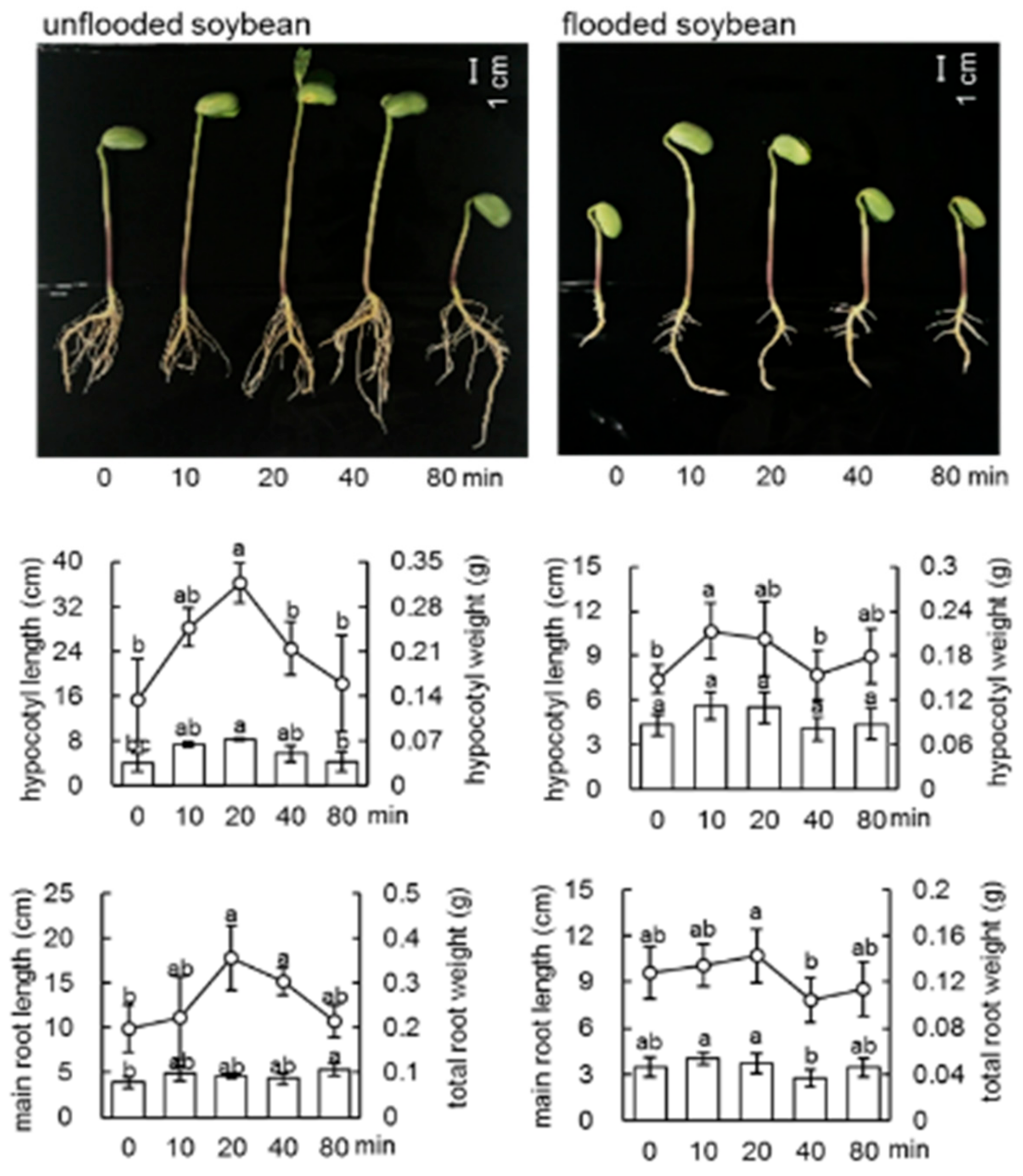
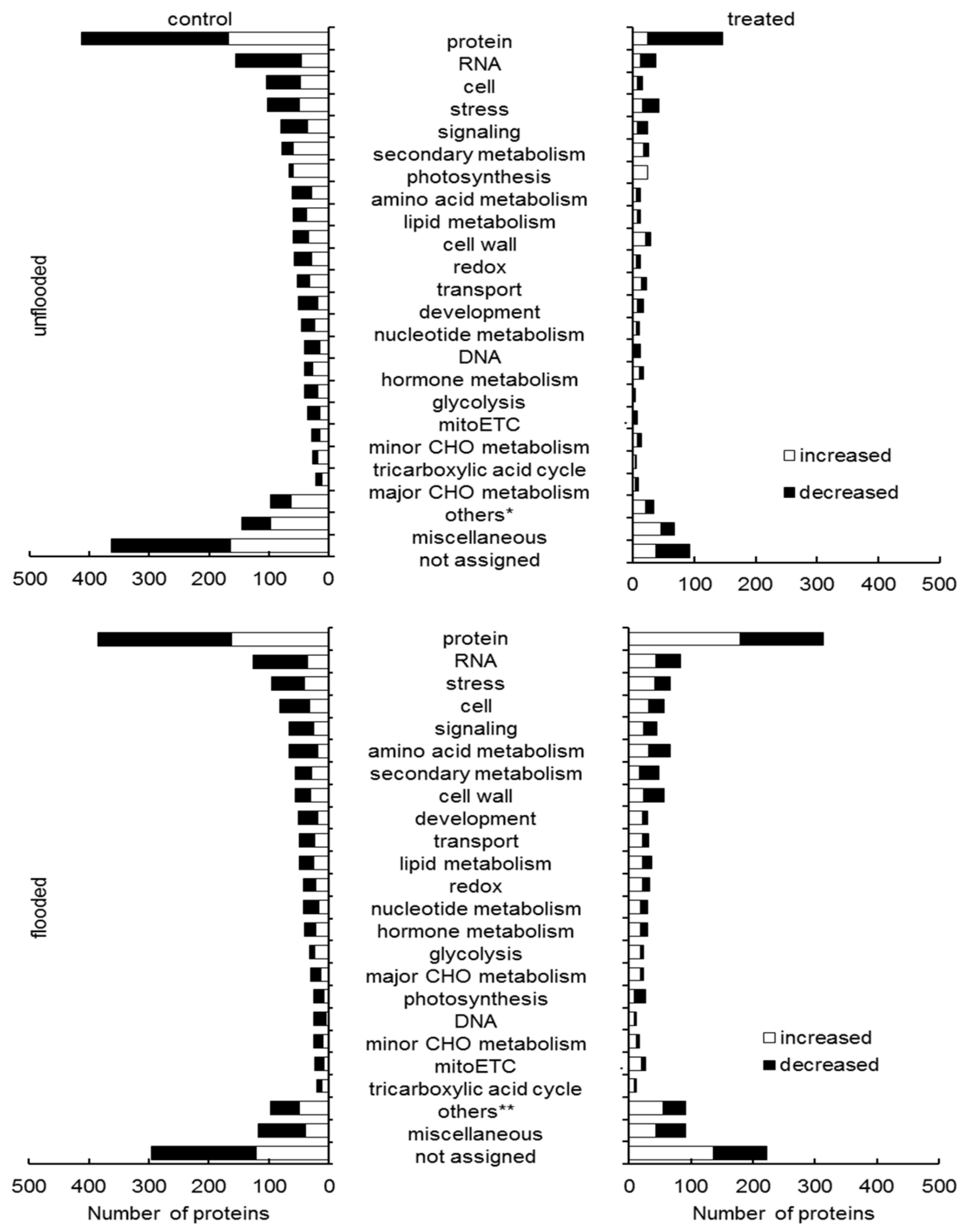
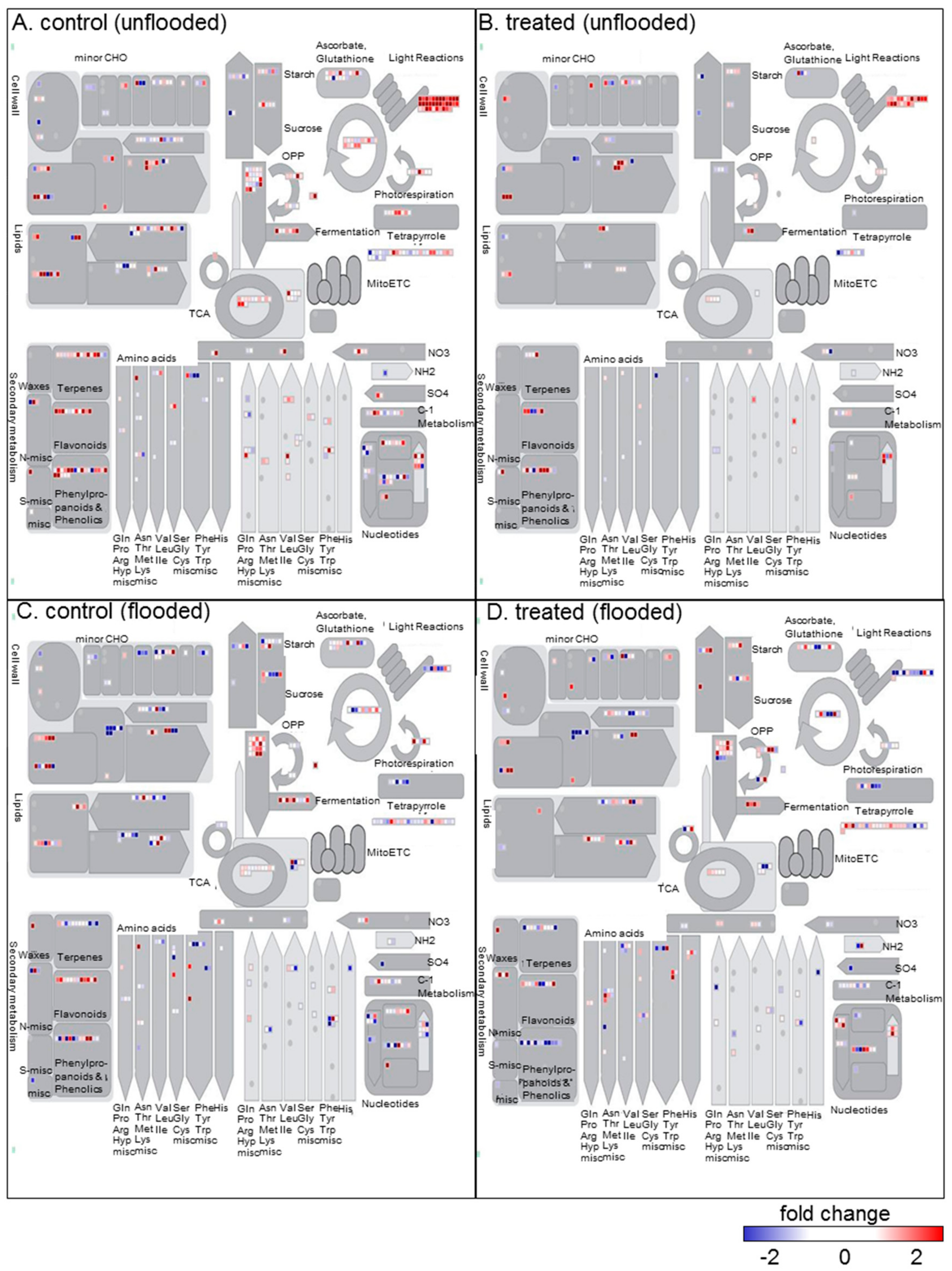

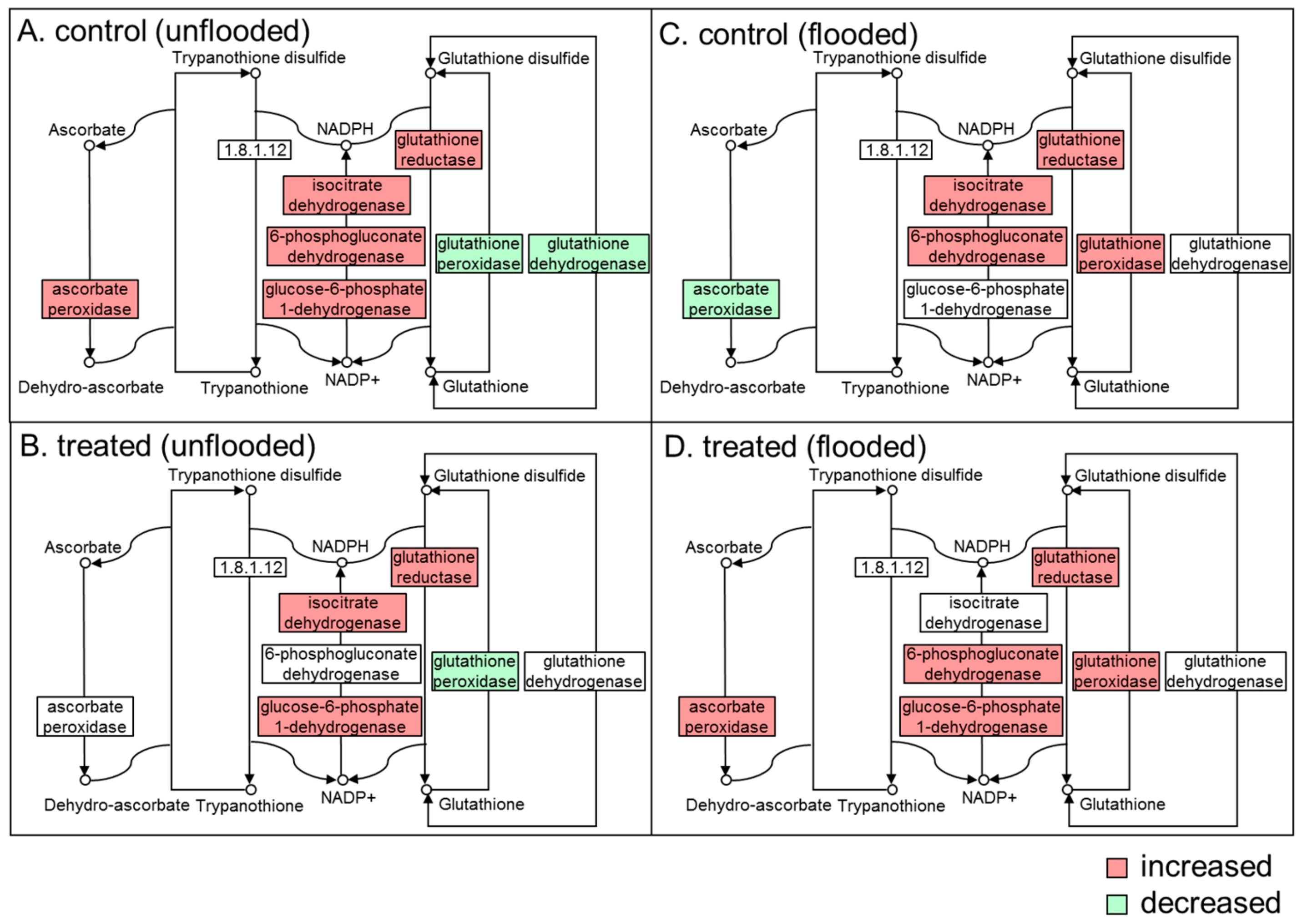
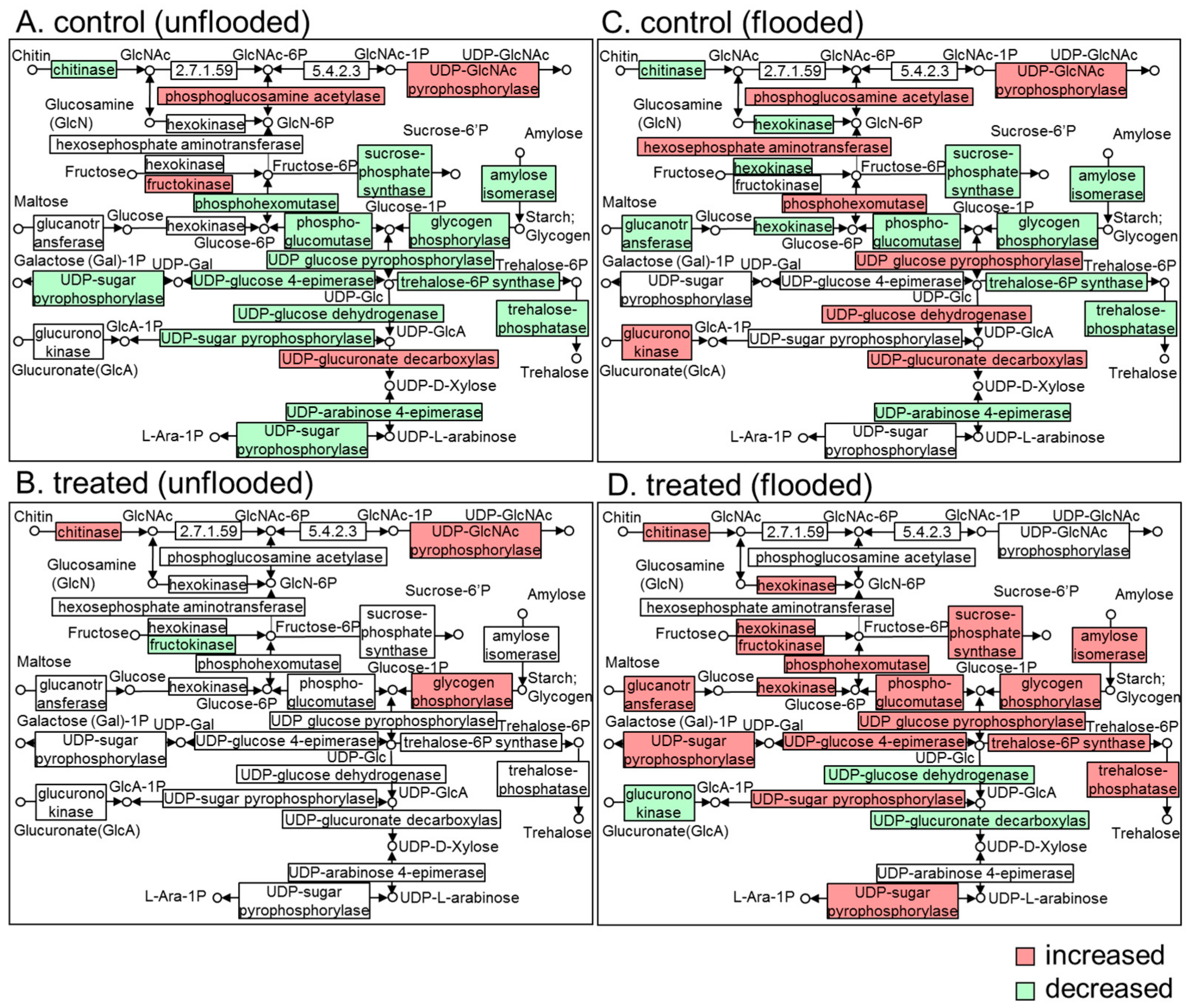
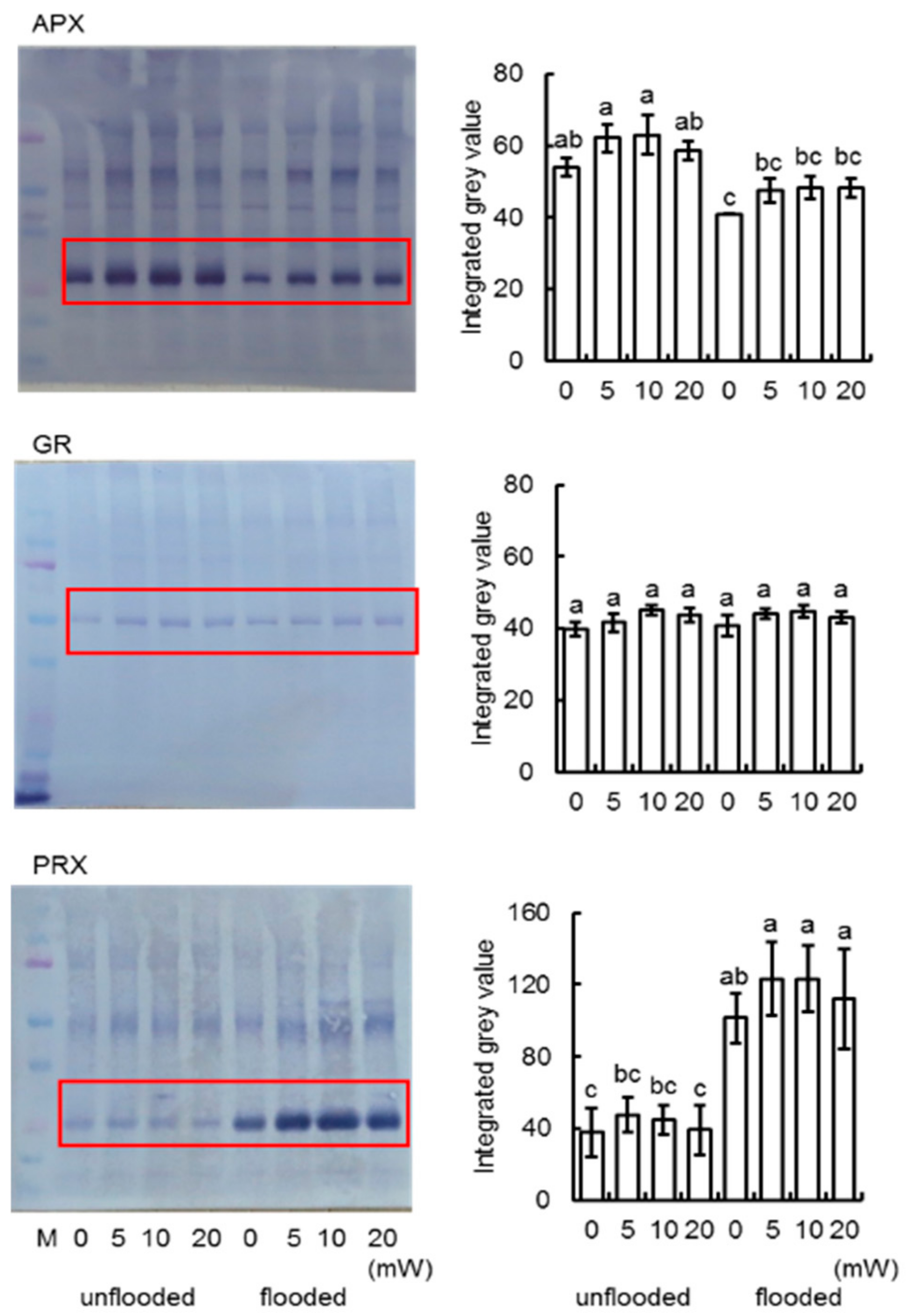
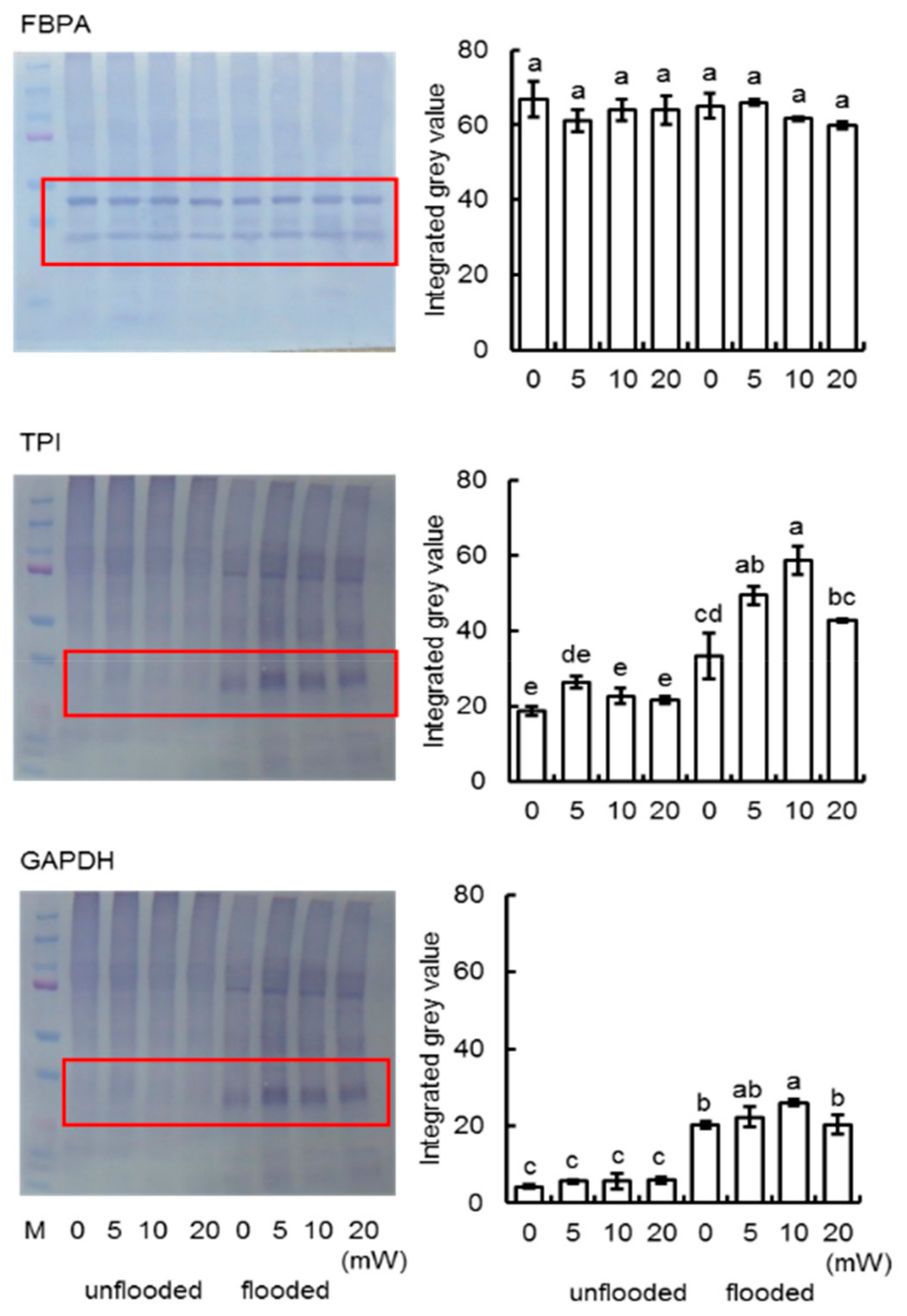
| Number | Accession a | Description | Functional Category b | Starting Point | Fold Change c | Flooded |
|---|---|---|---|---|---|---|
| Unflooded | ||||||
| 1 | I1JGU8 | phospho-2-dehydro-3-deoxyheptonate aldolase | amino acid metabolism | 1.22 | −0.61 | −0.63 |
| 2 | I1JEV7 | carboxylesterase 2 | biodegradation of xenobiotics | 0.72 | 0.35 | 0.56 |
| 3 | C6SX10 | mitochondrial fission 1 protein | cell | −2.26 | −1.39 | −1.66 |
| 4 | Q9M7N4 | MFP1 attachment factor 1 | cell | −1.51 | −2.43 | 2.60 |
| 5 | I1N3E1 | phosphorylethanolamine cytidylyltransferase 1 | cell | −0.72 | 2.31 | −2.30 |
| 6 | I1K6P4 | uncharacterized protein | cell | 1.02 | −0.66 | −1.58 |
| 7 | Q09WE7 | UDP-sugar pyrophosphorylase 1 | cell wall | −1.22 | 0.81 | 0.38 |
| 8 | V6CKR0 | expansin | cell wall | −0.76 | −0.38 | 0.54 |
| 9 | Q9SEK9 | seed maturation protein PM25 | development | −1.75 | −2.49 | −1.06 |
| 10 | I1L849 | seed maturation protein | development | −0.88 | −0.72 | −2.80 |
| 11 | I1LE33 | cupin family protein | development | −1.89 | −1.83 | −2.36 |
| 12 | I1L860 | cupin family protein | development | −3.01 | −3.54 | −3.28 |
| 13 | I1KY39 | citrate synthase | gluconeogenese/glyoxylate cycle | −0.46 | −0.40 | 0.56 |
| 14 | I1LY51 | 12-oxophytodienoate reductase | hormone metabolism | 0.70 | 0.53 | 0.37 |
| 15 | A0A0R0IYE6 | lipoxygenase | hormone metabolism | 0.85 | 1.43 | 1.34 |
| 16 | A0A0R0K553 | uncharacterized protein | hormone metabolism | −1.08 | −0.67 | −0.38 |
| 17 | A0A0R0GAV8 | acyl-CoA dehydrogenase family member 10 | lipid metabolism | −1.23 | −0.54 | 0.88 |
| 18 | I1MRK1 | 3-hydroxybutyryl-CoA epimerase | lipid metabolism | 0.97 | 0.77 | −2.38 |
| 19 | I1M928 | acyl-lipid (9-3)-desaturase isoform B | lipid metabolism | −2.52 | 1.61 | 0.98 |
| 20 | O22378 | metallothionein-II protein | metal handling | −3.07 | 2.56 | 0.40 |
| 21 | I1K146 | cytochrome c1-1, heme protein | mitoETC | −0.80 | −0.60 | 0.45 |
| 22 | C6SWW6 | cytochrome c oxidase subunit 6a | mitoETC | 1.11 | −0.35 | −0.98 |
| 23 | I1KEH3 | electron transfer flavoprotein subunit alpha | mitoETC | −0.38 | −0.32 | 0.88 |
| 24 | I1J9Q7 | glutamate dehydrogenase | nitrogen metabolism | −1.31 | −0.61 | 3.52 |
| 25 | I1ML46 | uncharacterized protein | nucleotide metabolism | 1.53 | 1.08 | 1.06 |
| 26 | Q2PMU2 | photosystem I P700 chlorophyll a apoprotein A2 | photosynthesis | 1.52 | 0.70 | 3.04 |
| 27 | P49161 | cytochrome f | photosynthesis | 1.21 | 0.85 | 0.69 |
| 28 | A0A0R0I8Z5 | chlorophyll a-b binding protein | photosynthesis | 1.18 | 0.91 | 1.72 |
| 29 | Q2PMQ9 | photosystem II CP47 reaction center protein | photosynthesis | 1.12 | 0.74 | 1.42 |
| 30 | A0A0R4J389 | photosystem I reaction center subunit III | photosynthesis | 1.13 | 0.94 | 3.00 |
| 31 | I1MUQ0 | ATP synthase delta chain | photosynthesis | 0.73 | 0.69 | 1.07 |
| 32 | K7KJ72 | uncharacterized protein | protein. degradation | 0.24 | −0.38 | −0.51 |
| 33 | I1M4G0 | carboxypeptidase | protein. degradation | 1.16 | 0.52 | 0.81 |
| 34 | I1MIC1 | metacaspase-4 | protein. degradation | 1.19 | −0.29 | 0.30 |
| 35 | C6TFY7 | chaperonin 10 | protein. folding | 5.47 | −0.63 | −6.07 |
| 36 | I1K5E6 | guanine nucleotide-binding protein subunit | protein. post translational modification | 0.38 | −0.30 | −0.48 |
| 37 | C6SVV1 | 60S ribosomal protein | protein. synthesis | −1.37 | −0.40 | 1.35 |
| 38 | C6SXD3 | 40S ribosomal protein S24 | protein. synthesis | 0.51 | −0.52 | −0.95 |
| 39 | I1MDJ2 | 60S ribosomal protein L23A isoform | protein. synthesis | 0.90 | −0.67 | −1.05 |
| 40 | A0A0R0EIR6 | glycosyltransferase | protein. synthesis | 2.63 | 2.39 | −1.93 |
| 41 | I1N1W7 | mitochondrial-processing peptidase subunit | protein. targeting | −0.41 | −0.41 | 0.40 |
| 42 | I1L0S5 | outer envelope pore protein 16-2 | protein. targeting | −0.93 | −0.91 | 1.39 |
| 43 | C6TB70 | 1-cys peroxiredoxin | redox | −0.36 | −0.69 | −0.41 |
| 44 | I1KFE9 | L-ascorbate oxidase | redox | 0.62 | 1.10 | 0.42 |
| 45 | I1LCG9 | pre-mRNA-processing factor 17 | RNA | −0.24 | −1.45 | 0.86 |
| 46 | K7LRU6 | apoptotic chromatin condensation inducer | RNA | −0.79 | −0.61 | 0.72 |
| 47 | I1KEW2 | O-methyltransferase 3 | secondary metabolism | 0.54 | 0.38 | 0.59 |
| 48 | F8WRI3 | gamma-tocopherol methyltransferase | secondary metabolism | 1.06 | 1.37 | −2.06 |
| 49 | I1K711 | uncharacterized protein | signalling | 0.48 | 0.54 | 0.72 |
| 50 | I1LBC8 | mitochondrial Rho GTPase | signalling | −1.08 | −1.10 | 0.93 |
| 51 | K7KIL0 | GTP-binding nuclear protein | signalling | 1.30 | −0.30 | −0.80 |
| 52 | K7LDT9 | low-temperature-induced 65 kDa protein | stress | −1.86 | −1.96 | −1.01 |
| 53 | C6T0C7 | trypsin inhibitor A | stress | 0.88 | 1.11 | 1.20 |
| 54 | A0A0R4J4G9 | heat shock 22 kDa protein | stress | −1.19 | −2.53 | −1.19 |
| 55 | A0A0R4J4S6 | NADPH-protochlorophyllide oxidoreductase | tetrapyrrole synthesis | 0.60 | −0.57 | 0.90 |
| 56 | C6TDZ1 | aquaporin PIP2-7 | transport | −0.68 | 1.25 | 0.92 |
| 57 | I1JMI9 | malic enzyme | tricarboxylic acid cycle | 0.55 | 0.20 | −0.38 |
| 58 | P15490 | stem 28 kDa glycoprotein | miscellaneous | 1.55 | 0.92 | 1.54 |
| 59 | K7L6U4 | uncharacterized protein | miscellaneous | 0.74 | 0.56 | 0.82 |
| 60 | P10743 | stem 31 kDa glycoprotein | miscellaneous | 1.59 | 0.77 | 0.85 |
| 61 | I1KZI4 | 2,3-dimethylmalate lyase | not assigned | −0.87 | 0.98 | 1.17 |
| 62 | I1MRP7 | uncharacterized protein | not assigned | −0.67 | −0.66 | 1.51 |
| 63 | K7LKS0 | exocyst complex component SEC5 | not assigned | −0.49 | −1.08 | −1.26 |
| 64 | I1LV40 | uncharacterized protein | not assigned | −0.46 | −0.76 | −0.70 |
| 65 | I1NA37 | uncharacterized protein | not assigned | −1.11 | −1.91 | 0.86 |
| 66 | K7MGN4 | trafficking protein particle complex subunit | not assigned | 0.57 | 0.66 | −0.49 |
© 2020 by the authors. Licensee MDPI, Basel, Switzerland. This article is an open access article distributed under the terms and conditions of the Creative Commons Attribution (CC BY) license (http://creativecommons.org/licenses/by/4.0/).
Share and Cite
Zhong, Z.; Furuya, T.; Ueno, K.; Yamaguchi, H.; Hitachi, K.; Tsuchida, K.; Tani, M.; Tian, J.; Komatsu, S. Proteomic Analysis of Irradiation with Millimeter Waves on Soybean Growth under Flooding Conditions. Int. J. Mol. Sci. 2020, 21, 486. https://doi.org/10.3390/ijms21020486
Zhong Z, Furuya T, Ueno K, Yamaguchi H, Hitachi K, Tsuchida K, Tani M, Tian J, Komatsu S. Proteomic Analysis of Irradiation with Millimeter Waves on Soybean Growth under Flooding Conditions. International Journal of Molecular Sciences. 2020; 21(2):486. https://doi.org/10.3390/ijms21020486
Chicago/Turabian StyleZhong, Zhuoheng, Takashi Furuya, Kimitaka Ueno, Hisateru Yamaguchi, Keisuke Hitachi, Kunihiro Tsuchida, Masahiko Tani, Jingkui Tian, and Setsuko Komatsu. 2020. "Proteomic Analysis of Irradiation with Millimeter Waves on Soybean Growth under Flooding Conditions" International Journal of Molecular Sciences 21, no. 2: 486. https://doi.org/10.3390/ijms21020486
APA StyleZhong, Z., Furuya, T., Ueno, K., Yamaguchi, H., Hitachi, K., Tsuchida, K., Tani, M., Tian, J., & Komatsu, S. (2020). Proteomic Analysis of Irradiation with Millimeter Waves on Soybean Growth under Flooding Conditions. International Journal of Molecular Sciences, 21(2), 486. https://doi.org/10.3390/ijms21020486







